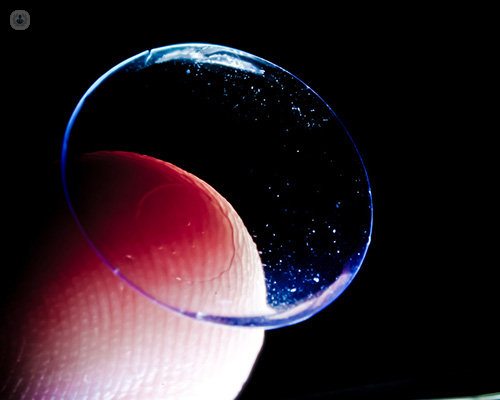


What is astigmatism?
Astigmatism is a condition in which the eye is slightly oval-shaped, leading to blurred vision. It is fairly common and is usually treated with glasses.
What are contact lenses for astigmatism?
Many patients with astigmatism believe they cannot use contact lenses, but most, in fact, can. There are several forms of contact lens that are suitable for the majority of astigmatism patients. Common examples include the following:
Toric contact lenses
Toric contact lenses are usually soft lenses made from either conventional hydrogel material or a highly breathable silicone hydrogel (although some more rigid gas permeable varieties exist as well).
Toric soft lenses for astigmatism are not the same as soft contact lenses for short-sightedness or far-sightedness. Whereas these have the same power throughout the lens, Toric lenses have different powers in different parts of the lens, as astigmatism causes varying amounts of near-sightedness and far-sightedness at different meridians of the eye. They are also designed so that the lens aligns with the appropriate part of the eye.
Due to the complex design of toric lenses, and the fact that every astigmatism case is different, they are generally more expensive than normal lenses and require some expertise to find the perfect brand and design for each patient.
Gas permeable contact lenses
Rigid gas permeable (GP or RGP) lenses are often able to correct astigmatism even if they do not have a toric design, as they retain their shape rather than following the irregular shape of the cornea as soft lenses do. Toric GP lenses are generally only required for unusual types and high levels of astigmatism. While GP lenses usually provide clearer vision than soft lenses, they can be uncomfortable and some patients find them difficult to adapt to.
Hybrid contact lenses
Hybrid contact lenses combine aspects of the previous two types, having a rigid, gas permeable lens in the centre, with a soft fitting region around the outside, made of a hydrogel or silicone hydrogel material. Some patients find these to be the superior option, as when successfully fitted they provide both sharp vision and relative comfort while wearing.
Like with GP contacts, it takes more time and greater expertise to fit hybrid lenses than soft lenses. They also do not need to be replaced as frequently as their soft counterparts. They are custom-made for each patient and usually cost a similar amount to GP lenses.
